We’re out exploring the beautiful Border Ranges and Mount Barney for the next couple of days.
Here’s a sneak preview of some of the amazing scenery around here.
Continue Reading

We’re out exploring the beautiful Border Ranges and Mount Barney for the next couple of days.
Here’s a sneak preview of some of the amazing scenery around here.
Continue Reading
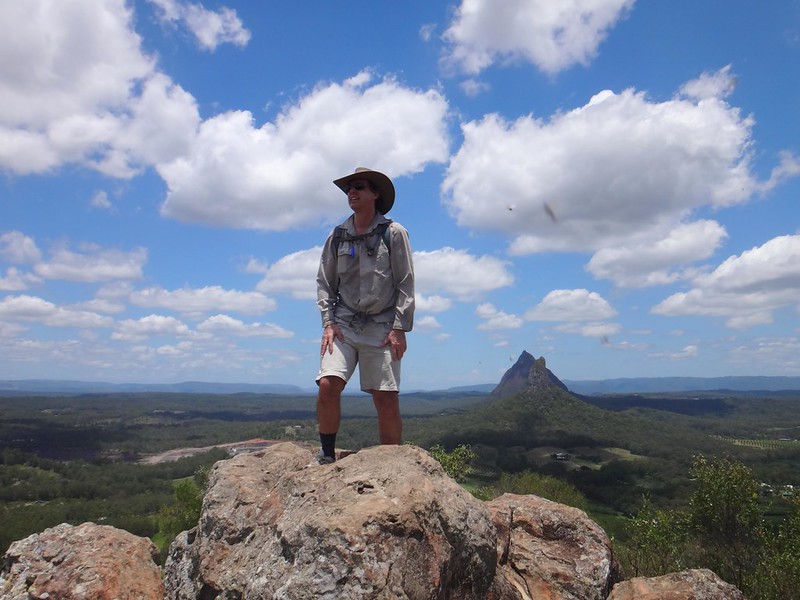
My daughter Laura and her partner Ken are visiting us from Scotland for a few days, so I thought today would be a good opportunity to enjoy some on-foot exploration of the Glasshouse Mountains.
Although they’re half a world away from the bonnie braes and glens of Scotland, the ancient volcanic Glasshouse monoliths have a timeless beauty of which I never tire.
Continue Reading

The aim of today’s adventure was to join up a couple of sections on my “map”. I’ve ridden through Wooroi forest at Tewantin several times (and loved it). I’ve also ridden through the spectacular Noosa Trails Network near Cooroy, Pomona and Kin Kin. But I hadn’t explored the country in-between these two places, so I thought I’d check it out.
I parked the car half-way between Cooroy and Pomona and set off towards Lake Macdonald. This area has a wonderful network of trails, so I just followed the trail markers.
Lake Macdonald is an artificial lake formed when Six Mile Creek was dammed in 1965 to provide water for the Noosa shire. Today it’s home to a wide variety of birdlife and fish, including the rare Mary River Cod.

From the lake, I headed east along Collwood Road. I had plotted an ambitious course into my GPS that would take me down this road, around the back of nearby Mount Tinbeerwah (which I wanted to climb) and then to my final destination at Tewantin State Forest….

I happily followed my GPS along the quiet trails, oblivious to the fact that I had configured the GPS incorrectly. Instead of following my course, the GPS was in “navigate” mode. It was taking me on the shortest route between the two points. I was unaware that I was “off course” and just kept blindly following my GPS…

… and got spat out on a main road. I was very disappointed! My original course would have taken me through some great forests, but my GPS had taken me to a busy Sunshine Coast thoroughfare. I was on foot, and had limited range because of my injury, so I had no choice but to soldier on. I had determined that my sensible limit for the day was about 10km. Doubling back would have added another 5 or 6 km to that, which wouldn’t have worked for me.
After a slow couple of kilometres walking along the main road, I eventually reached Wooroi Forest at Tewantin. I’d passed this spot several times on the mountain bike. Today I met a happy Roadie riding up Gyndier Drive. This road used to be an old race track, winding up the hill. In fact once or twice per year vintage cars still race to the top. Most other days, cyclists use the hill to test their strength. It’s not terribly steep, but the long consistent gradient provides a good challenge.

I also passed a few mountain bikers on their way to the forest trails.


Today was polling day. By a strange co-incidence, the end-point of my hike was at a polling booth busy with people arriving to vote in the Federal Election. A few of the booth workers from the different parties agreed to get together for a group photo. I told them I thought they were amazing to spend their time working for a cause they believed in. Even though they were diametrically opposed to each other on some issues, they had more in common than they’d normally admit, which is why I think they were quite happy to pose together for this photo.
The bird-life didn’t get a vote today 🙂
I’d walked about 9km so far, but I still wanted to climb to the summit of Mount Tinbeerwah. I decided to catch a cab back to the car, and drove to the car park at the base of the mountain.

It’s a 500 metre walk from the car park to the summit of Mount Tinbeerwah. The path is paved all the way, with seats placed at strategic intervals for tired hikers.

The 360 degree panoramic views at the top are worth the easy climb. I can’t think of an easier climb on the Sunshine Coast which yields such an amazing vista. If you measured it in terms of view quality versus the effort it takes to get there, the Tinbeerwah Summit is about the best value you can get.
I met Ian and Angela at the top. They kindly agreed to let me take their photo, and to take one of me. Angela once had a similar knee injury to me, so we exchanged notes while clicking away on the camera.
Another enjoyable adventure came to an end. It didn’t go as planned. In hindsight, that was ok because half the fun was dealing with the surprises. As I think about it, an adventure isn’t about getting from the start to the finish – it’s about what happens in between!
All up I walked 10km in 3.5 hours including breaks. I’d really like to explore some more of this area in future.
North Stradbroke Island is a stunning sand island which frames the eastern border of Moreton Bay, near Brisbane. It’s the second largest sand island in the world, after Fraser Island – a couple of hundred kilometres further north.
I spent a day roaming over this special place with my son, Jonathan.
Until about a century ago, it was one island. During a fierce storm, a ship laden explosives was wrecked on the Jumpinpin Bar. Local authorities detonated the explosives rather than risk a catastrophe while trying to retrieve the cargo. This weakened the sand bar, which allowed rough seas from the storm to break through, cleaving the island in two, forming a new passage between North and South Stradbroke Islands.
“Minjerribah” is the aboriginal name for Stradbroke Island. “Moorgumpin” is their name for Moreton Island. These islands, together with all of Moreton Bay are known as “Quandamooka” country. The Quandamooka Aboriginal people comprise three groups: The Goenpul and Noonukul from Minjerribah, and the Ngugi from Moorgumpin.

The only way to get to “Straddie” is by boat. Our ferry left Cleveland at 5:15am, so I had to get up at 3am in order to pick up Jonathan and get to the ferry on time.
Bleary eyed, and dosed up to the eyeballs with strong coffee, we stood out on the deck of the ferry, “Big Red Cat”, and marvelled at the amazing dawn.
As we drove off the ferry, our first destination was Brown Lake – an elevated fresh water lake in the middle of the island.
The sun was just rising over the hills as we arrived, so in true tourist fashion we gaped at the beauty while clicking off dozens of photos. It’s not every day you get to see a sunrise over a pristine freshwater lake.
A little further towards the east we arrived at the “Eighteen Mile Swamp” a coastal freshwater swamp stretching for almost 30 kilometres behind the coastal dunes. This amazing lake is the largest of its kind in the world and is home to a large number of rare and endangered species.
The swamp, surrounding forests, and dunes form part of the Naree Budjong Dara National Park. “Naree Budjong Dara” means “My Mother Earth” in the language of the Quandamooka people.
The beach here stretches as far as the eye can see in either direction. It was a wonderful feeling to be one of only a handful of people on the entire beach. Lots of space is good for the soul.
It’s important to remember that the beach is an official road, and that vehicles could pass by at any time. These drivers were bogged in sand and were desperately trying to free their car by scooping sand out from under the tyres.
As we made our way back from the beach, we stopped for a short walk around Toroise Lagoon – another fresh water lake that forms part of the “Blue Lake” system.
Because of my knee, I didn’t feel able to complete the full 6km walk around Blue Lake, but I felt pretty good about doing the shorter 3.5km loop around Tortoise Lagoon instead.
Back on the bay-side of the island near Dunwich, we checked out one of the few remaining Shell Middens on the island. Over centuries, Aborigines would sit around here, enjoying shellfish, oysters, crabs, etc. The left-over shells were discarded in a large pile. Over time this heap grew to several metres in width and a couple of metres high. I explained it to Jonathan as the remnants of a two-thousand year long indigenous seafood party.
“Imagine being able to go out on the rocks and pick up a handful of Sydney Rock Oysters, or Moreton Bay Bugs whenever you wanted”, I said to Jonathan.
Before European colonisation, this place was paradise. Life here must have been full of contentment.
We then made our way northwards towards Amity Point, at the north-western tip of the island.
This is a fascinating point for a number of reasons:
It’s not far from here across the treacherous South Passage to Moreton Island. This is a dangerous passage because of shifting sand bars, strong currents, and unpredictable conditions.
At this point in 1823, the local Aboriginal people had their first face to face contact with Europeans. Last week I wrote about three shipwrecked ticket of leave convicts who were rescued by John Oxley on Bribie Island. Finnegan, Parsons and Pamphlett were washed ashore on Moreton Island. The Ngugi people on Moreton kindly fed these poor begraggled strangers for two weeks, and then rowed them across the South Passage to Amity Point. The Noonukul cared for them for another five weeks before eventually sending them on their way across the bay to the mainland via Peel Island, coming ashore near Ormiston.
A couple of decades later, Europeans were colonising Moreton Bay, including the Island. Amity Point was chosen as a Pilot station because of its proximity to the South Passage. The Cargo Ship, Sovreign, was moored off Amity for over a week in heavy weather. She attempted to clear South Passage, but was wrecked in the process, going down about two kilometres off shore.
A group of Aboriginal men, some from Minjerribah, some from Moorgumpin swam to the wreck, at great risk to their own lives. They were able to save the lives of ten passengers. Unfortunately, 44 people drowned.
It was a tragedy, but the aboriginal men were heroes, and were honored by the NSW government for their bravery.
Today, two of these brave men, Toompany and Nuggin, have streets in Amity named after them.
As we drove along the northern tip of the island, towards Point Lookout, Jonathan and I discovered more historical gems at Cylinder Beach.
In 1803, the colonial ships, “Cato” and “Porpoise”, were wrecked on reefs east of Gladstone. Matthew Flinders took the ship’s cutter, and decided to sail the small open boat back to Sydney with thirteen other men. After sailing 600 km south, they were running dangerously low on water, and anchored off Cyclinder Beach to find water. Some aborigines on the cliffs saw them, and signalled to them where they could find fresh water from a small creek nearby. After refilling their casks, the crew were able to complete the perilous 1,000 km voyage to Sydney.

When we looked along Cylinder Beach today, speckled with holiday makers, it seemed a long way from the remote water stop for thirsty sailors over two centuries ago.
The warm turquiose ocean is stunning to look at here. As I soaked in the beauty it occurred to me that the original inhabitants of this place were fortunate to live happy, healthy lives in one of the most bountiful places on the planet. They enjoyed a standard of living higher than most of the Europeans who were trying to colonize them. In most early contacts, they responded with kind-hearted generosity.
Thomas Pamphlett came from the north of England during the industrial revolution. It would have been cold, dirty and crowded. His poverty would have made it difficult to find food to eat each day. I wonder how he would have remembered his seven weeks in the sun with the Quandamooka people?
At Point Lookout, on the north-eastern tip of the island, we walked around North Gorge. This is a spectacular inlet where the waves rush up the narrowing gorge.
It’s also a great spot to gaze out at the Pacific Ocean and watch for migrating Humpback whales.
You wouldn’t believe it was the last day of “winter” – the warm water was full of surfers.
From the headland we were able to look southwards down Main Beach as far as our eyes could see.
What an amazing place. I’m definitely coming back here on a bike when I am able 🙂
All up we travelled about 220km. It was 55km each way to the ferry at Cleveland, 10km each way across the bay and back on the ferry, and about 100km of driving on the island. To take a car on the ferry costs about $140, although during the winter months if you catch the early ferry it only costs $80. For a car with 4 or 5 passengers all contributing to the fare, it works out pretty cheaply.
We spent 9 hours on the island and didn’t feel rushed looking at all the things we wanted to see.
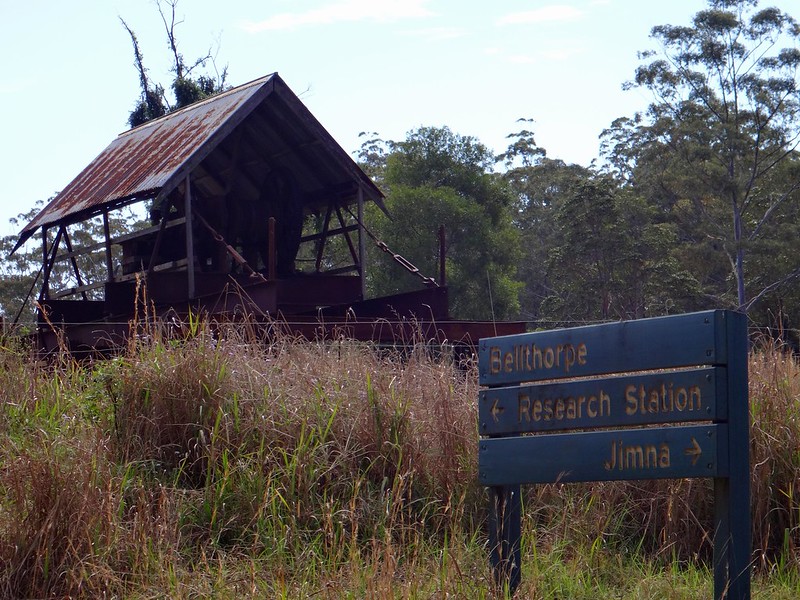
Today’s adventure had a couple of objectives. I wanted to close a gap in my map in Bellthorpe Forest. It was only about 2km in length, so I thought it would be achievable on foot, which would suit my current situation of not being able to ride a bike.
The other objective was to spend some time at Mount Mee an enjoy some of the amazing views.
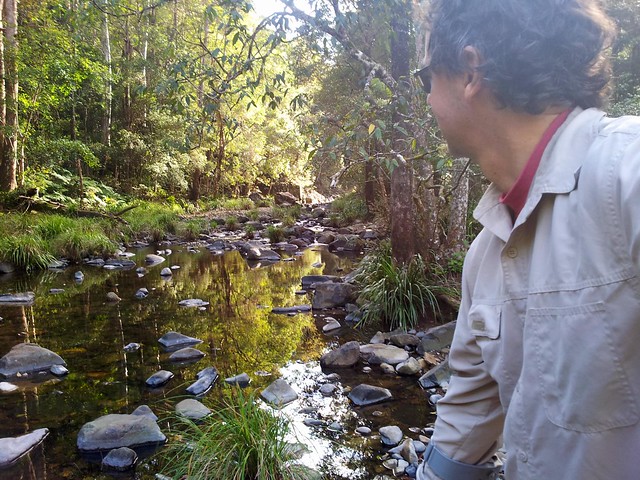
I started the day at the Stoney Creek day-use area at the bottom of the range in Bellthorpe National Park. Stoney Creek runs down the southern slopes of the Conondale Range before eventually flowing into the Stanley River.

I thought this might be a great spot to re-visit in the heat of summer. The water in the rock pool here is bright blue. It looks like it would be a delicious place to cool off in the warmer months.
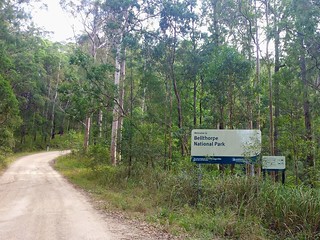
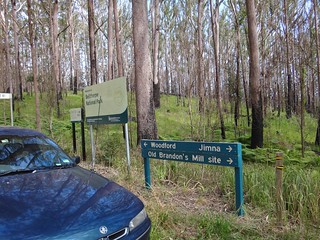
From Stoney Creek I slowly made my way up the mountain to Bellthorpe. The road is steep and twisty, so I took my time, enjoying the view.
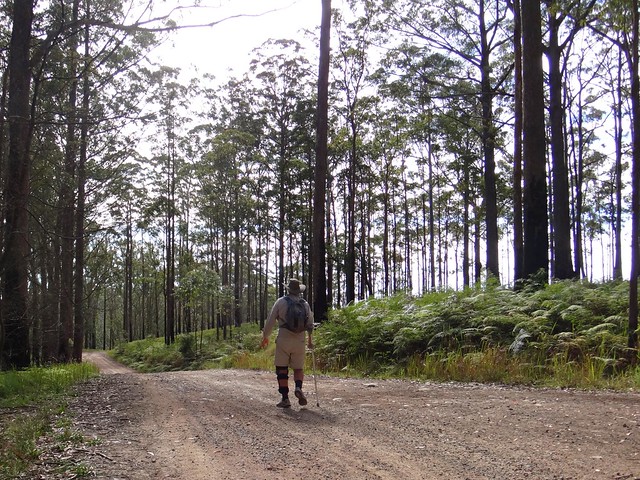
At this point I parked the car, and set off on my short hobble/hike to the sawmill.
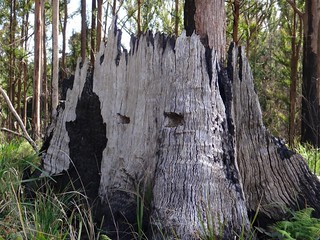
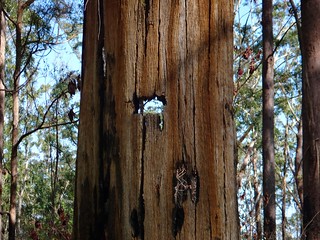
There’s plenty of evidence of logging from bygone days in this forest – you just need to know where to look. When trees were cut by hand, loggers would cut a square recess in a tree’s trunk which would then hold a wooden plank. They’d stand on the plank and either chop the tree, or cut another recess for yet another plank. You can still see the square holes in old tree stumps where the recess was cut by the logger.
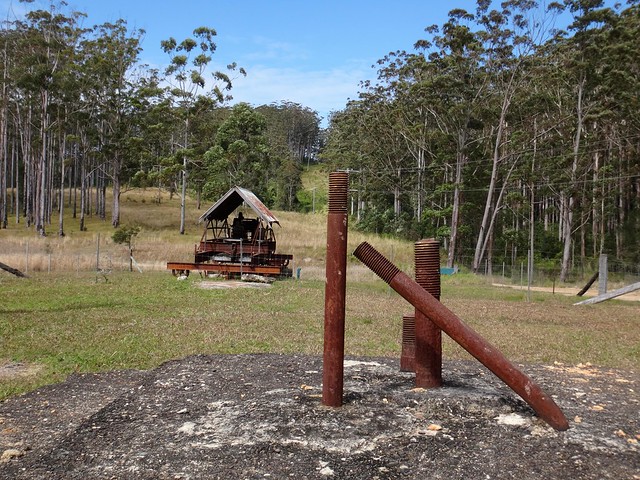

The ruins of the sawmill show evidence of an old Gantry, crane, band saw and building foundations. They’re slowly being reclaimed by nature in its slow-motion revenge over the rusting machinery. The mill is a reminder that, like many other national parks and state forests, this place was once heavily logged.
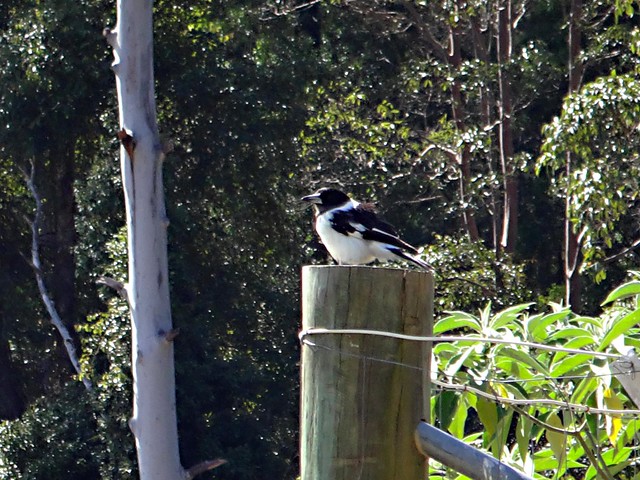
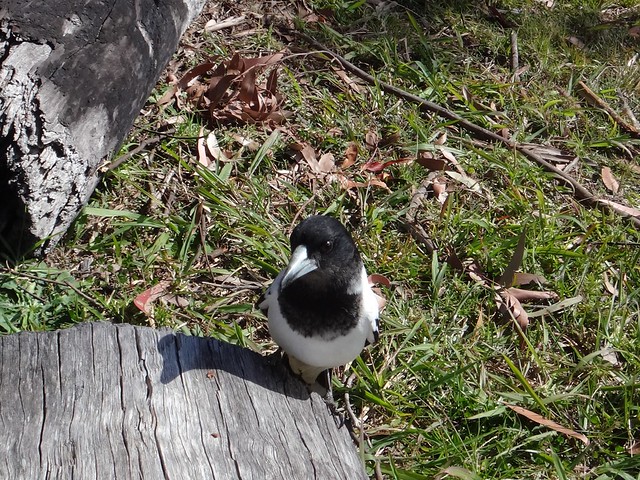
As I sat on an old log, munching on my chocolate bar, a butcher bird found me, and sat down next to me – less than half a metre from me. I could have reached out and touched him if I wanted. He just looked at me as I ate, and made a pathetic chicken-like sound that was unmistakable. He wanted what I had…

…so I obliged. He was very grateful as his mate looked on enviously from a safe distance on an adjacent log. I didn’t know butcher birds like chocolate. I think perhaps they like whatever it is anyone else is eating – regardless of what they’re eating.
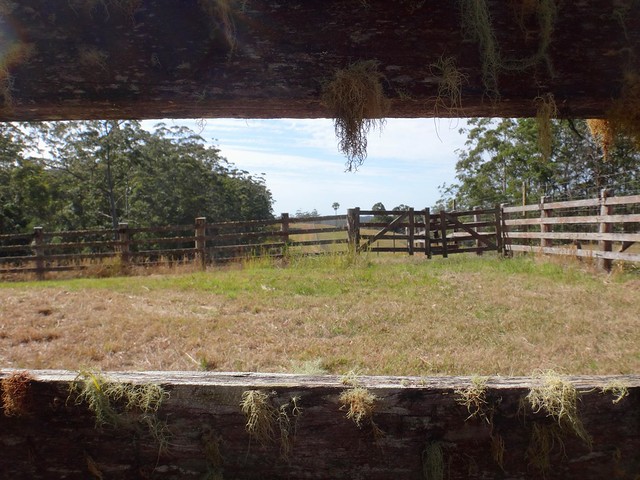

Nature seems to be taking over other things too. The lichen is growing very happily on the palings of this this cattle yard fence.
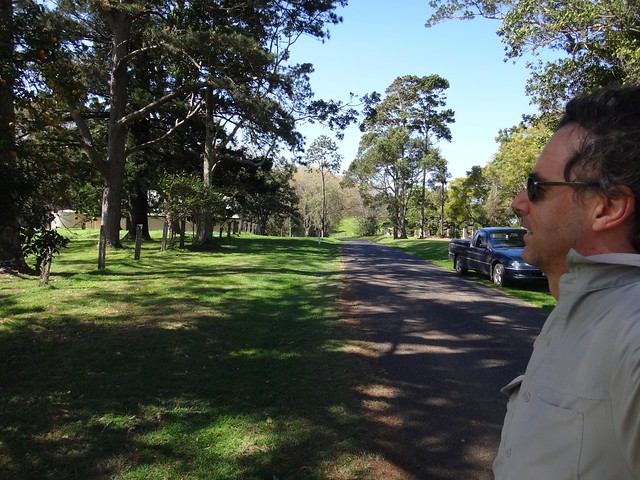
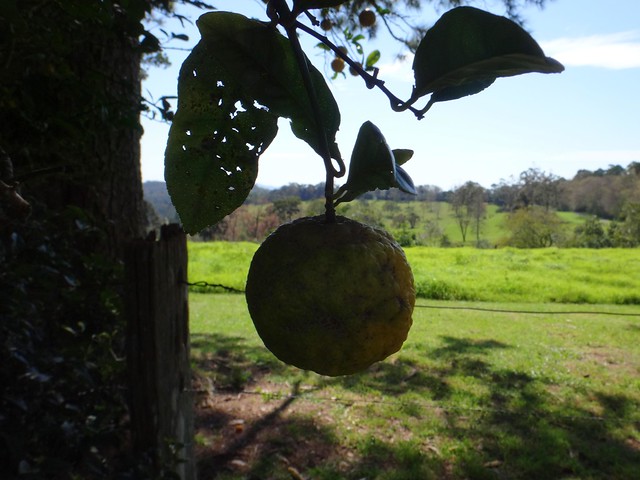
After I arrived back at the car, I slowly drove eastwards along the top of the range, over “Livingstone Hill” and through the small community of Bellthorpe. In the city below, the temperatures were quite balmy. But up here in the mountains, the breeze still had a pleasant chill to it. I parked a the car by the road and grabbed a few wild lemons growing by the side of the road. I’m not totally convinced Liz likes me bringing this sort of thing home as a “gift”, but it does my ego good to think that in some way I’m still playing the role of a primitive hunter gatherer.

Bellthorpe Range Road offers some amazing views of the Glasshouse Mountains as it slowly winds back down the mountain.
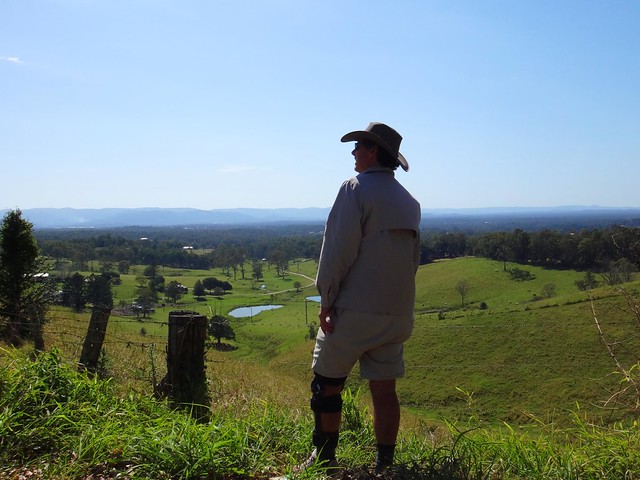
After a quick lunch in Woodford I made my way up to Mount Mee via Delaney’s Creek. On the way up, I stopped and had a bit of a look towards the north, and could make out the Conondale Range in the distance. It’s always fun to look back and get an idea of where you’ve been.
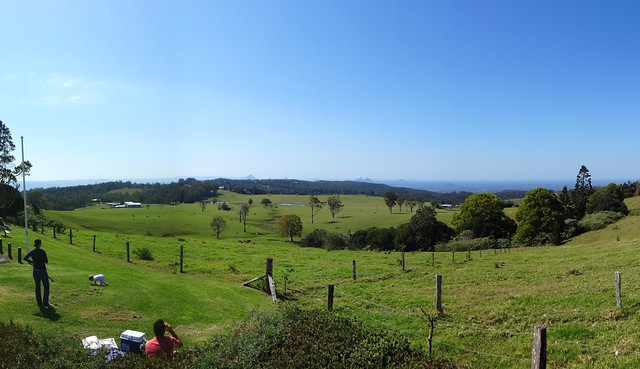
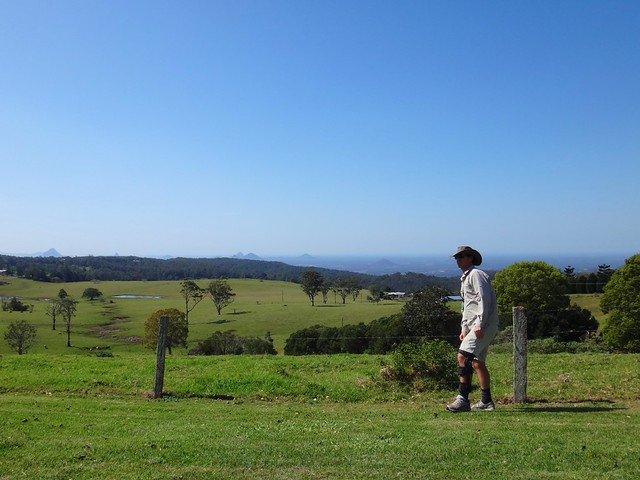
I made a quick stop at the Mount Mee lookout to soak in the views. Lots of other people had the same idea. What a glorious day – the views went on forever.

Eventually I made my way to Somerset Lookout near the Gantry at Mount Mee. Like Bellthorpe, Mount Mee also has a history of logging, as is evidenced by the huge gantry at the day use area. As I enjoyed the vista before me, I thought the last thing you’d want to do is log it.
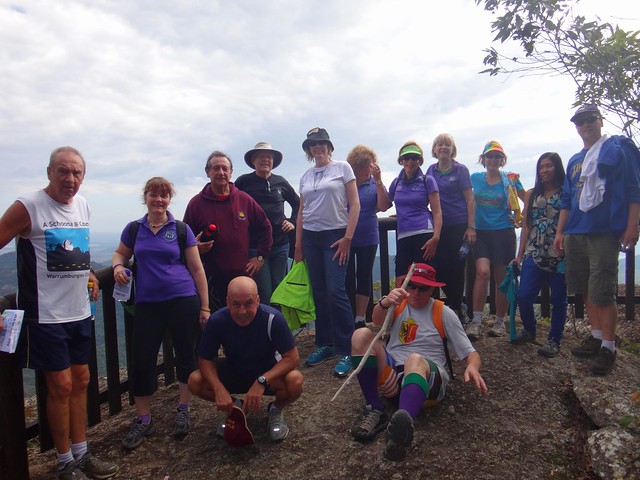
I was fortunate to meet up with some happy hikers from the Hash House Harriers – a social group of runners. They describe themselves as drinkers with a running problem. I was delighted to meet up with such a cheerful group of people. Most people you meet in the bush are happy. I’m not sure if this means the bush makes you happy, or that it’s only happy people who decide they’d like to go hiking in the bush.
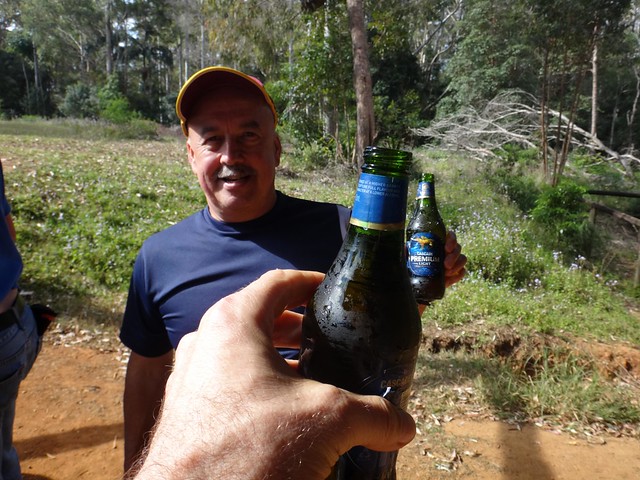
One of the hikers, “Beach Ball” (Harriers call each other by nick names rather than given names), decided he’d rather hitch a lift with me back to the gantry, instead of walking back. I was grateful for the company. He was grateful for the lift and gave me a beer when we got back. Cheers, Beach Ball!
The walk to Brandon’s mill was only 2.3km but it took me 1 hour 18 minutes including stops for photos. If you were doing this ride on a mountain bike, I’d suggest starting at either Woodford, or the Stoney Creek Day use area. You might get an idea for a route from this ride I did a couple of years back – but be prepared for a long climb up Stoney Creek Road. If you do this ride, I suggest you take the short detour to Brandon’s mill before going down Bellthorpe West Road. It would only add 10 or 15 minutes to your ride, but it’s a fascinating place.
The drive was just over 200km with some great lookouts. If you were lookiing for some places to take the family for a Sunday drive, some of these spots would be ideal.

Last week’s ride around Maidenwell was so fascinating that Eric and I decided to go back today and do a bit more exploration.
In 1986, Archaeologist and Paleoanthropoligist, MJ Morwood wrote a paper entitled “The Archaeolofy of Art: Excavations at Maidenwell and Gatton Shelters, Southeast Queensland”, which describes the results of a research project into social and economic complexity in Aboriginal society. One focus of the project was a rock shelter near Maidenwell which was culturally important to the Waka Waka people, and included rock-art and stone tools.
Eric and I were hoping to find the rock shelter. But more importantly we wanted to experience first-hand this magical place of impossibly placed boulders, wedge-tailed eagles and monoliths carved into amazing shapes by the hands of time.


We started our ride at Maidenwell, and headed west out of town until we found an old dirt track heading into the bush. Bain’s Road is named after Ron Bain who was mustering cattle in the area in 1972 and accidentally encountered the rock shelter. We ditched the bikes part way along this “road” and decided to go for a bit of a wander in the scrub.

The thing that immediately struck us was the way many of the huge boulders were perched in such precarious positions. It looked like some dream-time super human had picked them up and scattered them like play-things.



As we scrambled over rocks and through the lantana, we encountered this amazing Wedge-tailed Eagle’s nest, containing a solitary chick. Mr and Mrs Eagle were aparently out hunting for small dogs and stray children. The nest was perched atop a tree, over ten metres above the ground. But most impressive was the way the eagles had added to the nest each year until it was over two metres in height. I’d never seen such a huge nest before.


While we were trying to find the rock shelter, we kept encountering weird formations that looked like celestial marbles, or an Aboriginal “Stonehenge”.

This one looked uncannily like full-scale replica of a whale.


As we bashed through thick lantana, and scrambled clumsily over rock-faces in our cycling shoes, the rocks formations got stranger and it became obvious why this place is so spiritually important to the Waka Waka.

This one was stunning. How the heck do you end up with 4 boulders, each probably weighing ten tonnes, to sit on top of each other like that. Eric, the geologist, tells me it’s a result of millennia of weathering. My gut feelings suggested more supernatural origins.

Eventually the heat and lantana scratches got a bit much, so we sat in the cool shade of an overhanging boulder and had a short break and a snack.



Although the rock shelter eluded us, we both felt like we had an awe-inspiring experience wandering among these granite monoliths.

The loop we did on the bikes out of Maidenwell was only about 12km. The ride down Bain’s Road and Brooklands Peron Road is a lot of fun on a mountain bike and relatively easy. Some of the other tracks that we visited in the area are on private property, and should not be accessed without permission.

It’s taken two years and a couple of attempts but today Aaron and I finally made it to Dianas Bath.
Dianas Bath is a spectacular rock pool in the northern section of D’Aguilar National Park, fed by Byron Creek. It’s very difficult to get to – even if you have a 4WD (which I don’t), and it’s surrounded by steep hills, thick scrub and large boulders.
Todays ride started at the bottom of Wirth Road at Laceys Creek.
We slowly ground our way 6km to the top of the hill, then meandered through the forest until we reached Jacky Creek Road. This is a steep descent which switches back and forth down the mountain and devolves into some really fun steep single track towards the bottom.


Jacky Creek is a quiet pretty stream, but it flows in all weather, so it’s a bit of a challenge to cross. We managed to get to the other side and stay dry, which was quite an achievement.
From there we followed Dianas Bath Road to the end. This is a steep climb followed by a steep descent. In the past I found it so steep I had to push the bike in some parts. Today I just kept my head down and kept pushing the pedals around, and made it to the top. I was really pleased to tick this hill off the list. I must give credit to my riding buddy, Aaron, who spurred me on.
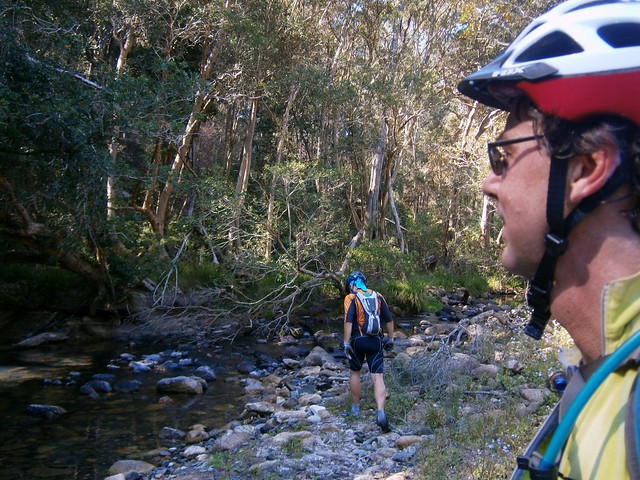
Eventually we had to leave the bikes behind and rock-hop along Byron Creek. This is tough because cycling shoes aren’t designed for walking in. Mine have carbon-fibre soles which hard hard and slippery. Walking on rocks in shoes like this is really difficult. In addition, the track was overgrown, we had to scramble over a few fallen trees, and the banks either side of the creek are steep and strewn with boulders. Oh, and did I mention the thorny “wait-a-while” vines that wrapped around our limbs?

After about half an hour of scrambling along the creek, we finally reached Dianas Bath. I was delighted. It was prettier (and bigger) than I imagined. My only regret was not bringing some swimmers. This place would be a lot of fun to swim in.

Aaron took his shoes off and waded in the water while I kept scrambling around on the edge of the pool looking for a Geo Cache.

My friend, Paul, created the Dianas Bath Geocache a few years ago. A Geocache is a small container containing trinkets and a log book. There are millions of them hidden all over the place. You can find out more here. I was delighted to finally log this cache after two years.

From there we headed back towards Mount Brisbane Road for the ride back to the cars, dodging lots of friendly goannas along the way.

Today we rode 52km in about five and half hours (including stops). We climbed about 1,750m of vertical ascent. I burned about 5,200kcal.
The ride included many slopes in excess of 25%, and some gradients in excess of 30%. This means you need to be fit enough to ride up the hills (or push your bike up), and confident enough to ride down them. Some of those slopes are slippery with dust or gravel.
I’m rating this one 9 out of 10 on the tough-o-meter. Take lots of water and plenty of snacks. Don’t do it in wet weather. Watch out for 4WD’s.
Thanks Aaron for a fun ride 🙂
Note: Dianas Bath is on private property. The owner currently allows walk-in access only. Please treat it with respect, clean up any mess you make, take all litter with you, and be courteous towards anyone else who is using the waterhole.

Here’s some photos of a recent hike along the Somerset Track, Mount Mee, that I did with my friend and business partner, Mark.




The 5km walk to the lookout covers a variety of terrain including rainforests, hoop pine plantations and open eucalyptus forests.



The views west from the lookout are spectacular, and well worth the hike out.

It’s an ideal spot to sit on the rock and have a bite to eat before walking back.

We crossed a few creeks on the return leg. Some of them were crystal clear.
On the drive home, we had a quick stop on Sellin Road to enjoy some amazing views of the Brisbane CBD off in the distance to the south-east.
13.1km in about 3 hours – this is a moderately difficult walk. Young teens would be able to handle it, but I would take younger kids.